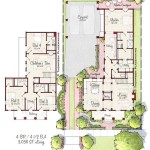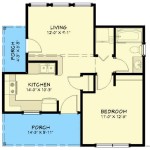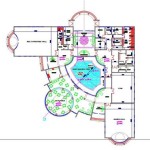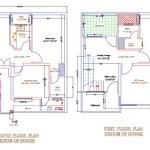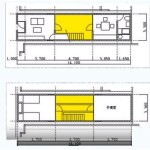Bathroom Floor Plans with Dimensions
Bathroom renovations require careful planning, and a key element of this process is a well-defined floor plan with accurate dimensions. A detailed floor plan ensures efficient use of space, avoids costly mistakes during construction, and helps visualize the final layout. This article explores various bathroom floor plans, incorporating dimensional considerations to aid in design and renovation projects.
A small bathroom, typically ranging from 30 to 40 square feet, requires a space-saving approach. A common layout for this size includes a standard 30-inch vanity, a toilet, and a 30x60 inch bathtub/shower combination. Careful consideration should be given to door swing directions and fixture placement to maximize functionality within the limited space. Wall-mounted vanities and toilets can create a more open feel. In a 5x7 foot bathroom (35 square feet), for example, positioning the door on the short wall can allow for a more elongated layout, facilitating the inclusion of both a toilet and a small shower.
Mid-sized bathrooms, typically between 40 and 70 square feet, afford more flexibility in design and fixture selection. In these spaces, a double vanity becomes a viable option, along with a separate shower and tub. A common layout for a 5x10 foot bathroom (50 square feet) could feature a 60-inch double vanity along one wall, a toilet adjacent to it, and a separate 30x60 inch shower stall opposite the vanity. The remaining space can accommodate a standard 60-inch bathtub. Careful planning is crucial to ensure comfortable circulation space around fixtures, typically a minimum of 24 inches.
Larger bathrooms, exceeding 70 square feet, offer greater design freedom. These spaces can accommodate luxurious features such as a separate water closet, a bidet, a larger soaking tub, or even a dedicated dressing area. For a 10x10 foot bathroom (100 square feet), a popular configuration might include a double vanity on one wall, a separate toilet and bidet in an enclosed water closet, a spacious walk-in shower, and a freestanding soaking tub. The ample space allows for the incorporation of additional storage solutions and design elements.
The Americans with Disabilities Act (ADA) compliant bathroom design emphasizes accessibility and safety. Specific dimensions and clearances are mandated to accommodate individuals with disabilities. For instance, a minimum turning radius of 60 inches is required within the bathroom. Toilet placement must allow for grab bars on adjacent walls, and the shower should feature a curbless entry for easy access with wheelchairs or other mobility aids. ADA-compliant bathrooms often require a larger floor area to accommodate these specifications. A common minimum size for an ADA-compliant bathroom is 5x8 feet (40 square feet), although larger dimensions are often preferred for enhanced usability.
Half bathrooms, also known as powder rooms, typically contain only a toilet and a sink. These small spaces, often ranging from 18 to 35 square feet, serve as a convenient guest bathroom. A typical 3x6 foot half bathroom (18 square feet) can comfortably accommodate a standard toilet and a small pedestal sink. Careful consideration should be given to door placement and fixture dimensions to maximize the limited space.
When designing a bathroom floor plan, consider the “bathroom triangle.” This design principle focuses on the relationship between the sink, toilet, and shower/tub. Ideally, these three fixtures should form a triangle, with the distance between each fixture no less than 60 inches and no more than 180 inches. This layout maximizes efficiency and minimizes traffic flow within the bathroom.
Incorporating accurate dimensions into your bathroom floor plan is essential for a successful renovation. Detailed measurements ensure that fixtures fit comfortably, that adequate clearance is maintained, and that the overall layout is functional and aesthetically pleasing. Consulting with a qualified contractor or designer can provide valuable expertise in optimizing space and ensuring compliance with building codes and regulations. They can also offer insights into material selection, plumbing considerations, and other crucial aspects of bathroom renovation.
Different layouts cater to various needs and preferences. A single-sink vanity is suitable for smaller bathrooms or those used by a single individual, while a double-sink vanity provides more countertop space and convenience for shared bathrooms. Choosing between a combined shower/tub unit and separate shower and tub installations depends on personal preference and available space. A separate shower offers greater flexibility in shower design and features, whereas a combined unit is a more space-saving option.
Software tools and online resources can assist in creating accurate and visually appealing bathroom floor plans. These tools allow users to experiment with different layouts, fixtures, and dimensions, providing a realistic preview of the finished bathroom. Many resources offer pre-designed templates for various bathroom sizes and configurations, which can be customized to meet individual requirements. Utilizing these tools can streamline the planning process and facilitate communication with contractors and designers.

101 Bathroom Floor Plans Warmlyyours

Henry Bathroom Floor Plans

101 Bathroom Floor Plans Warmlyyours

101 Bathroom Floor Plans Warmlyyours
%20(1).jpg?strip=all)
10 Essential Bathroom Floor Plans

Small Bathroom Layouts Interior Design Layout Plans

101 Bathroom Floor Plans Warmlyyours

Our Bathroom Reno The Floor Plan Tile Picks Young House Love

Bathroom Floor Plans How To Layout Your New 2024

Bathroom Floor Plan Examples


